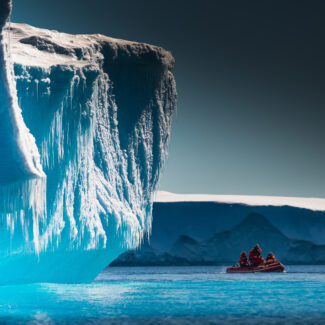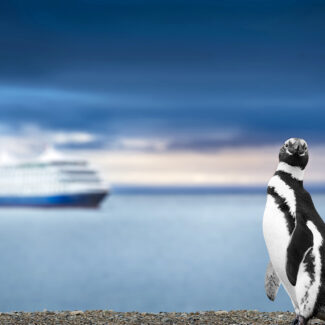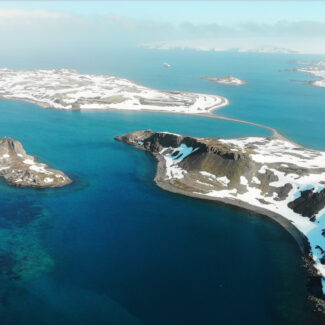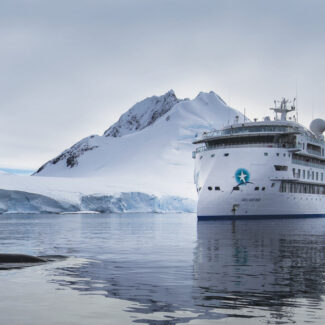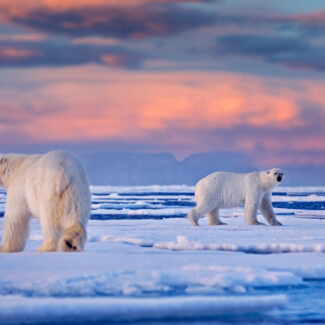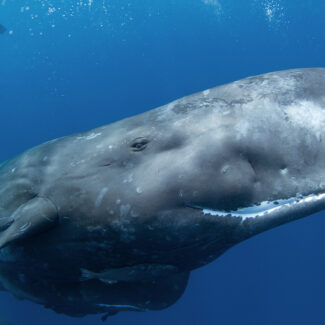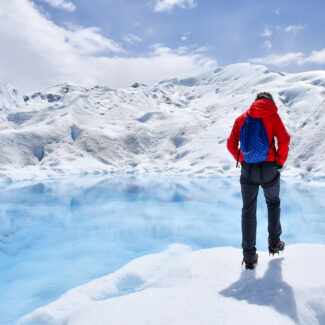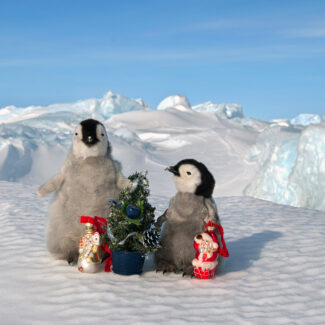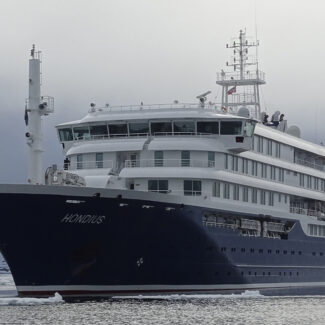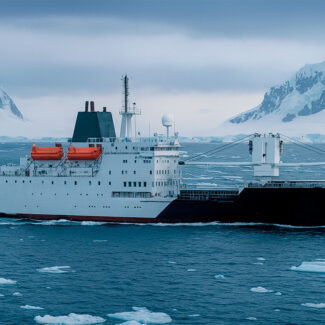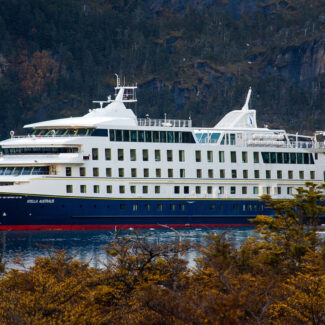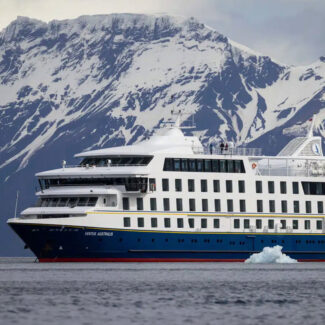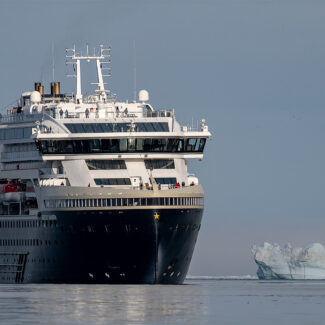
Northern Lights Cruises
Highlights
- Cruises to and around the Arctic Circle bring you deep within the “auroral oval” delivering the most consistent Northern Lights viewing
- Scoresby Sund in East Greenland is one of the most celebrated venues for the Northern Lights come late August and September, given its latitude and sky-clearing blasts of katabatic winds
- While autumn tours out of Scandinavia and Iceland often experience stormy weather and overcast conditions, new midwinter sailings out of Norway come with a Northern Lights guarantee
- Great opportunities to view the aurora, framed perfectly by snow-capped mountains, and illuminating drifting icebergs and veiled stars
- The solar maximum—the regular period of greatest solar activity during the Sun’s 11-year solar cycle—is creating some of the strongest and most vibrant aurora displays, making it one of the best times to visit the Arctic and witness the phenomenon
There aren’t many sights so awesome—in the fundamental sense of the word—than the Northern Lights (Aurora Borealis) going full blast. Formed when charged particles from the solar wind interact with Earth’s atmosphere, the Aurora Borealis (and their Southern Hemisphere counterpart, the Aurora Australis) cause shimmering curtains of red, violet, and green to pulse across the night sky. While occasionally seen at middle latitudes, auroras are most frequently and most brilliantly on display nearer the magnetic poles, which concentrate the streams of charged particles. No surprise, then, that the Arctic and subarctic are the epicenter for Northern Lights cruises.
Many travelers cruise to the Arctic in midsummer: a great time to do so, but not for Aurora Borealis cruises, given the Midnight Sun severely limits the hours of darkness that allow for Northern Lights viewing. Those looking to cruise to see the Northern Lights will do best to aim their getaway for the end of the main Arctic cruising season, when lengthening late-summer and early-autumn nights provide better conditions. And there are even some midwinter Northern Lights Norway cruises now on offer: about as good as it gets for witnessing the stunning show co-choreographed by the solar wind and Earth’s magnetic field.
About Northern Lights Cruises
There aren’t many sights so awesome—in the fundamental sense of the word—than the Northern Lights (Aurora Borealis) going full blast. Formed when charged particles from the solar wind interact with Earth’s atmosphere, the Aurora Borealis (and their Southern Hemisphere counterpart, the Aurora Australis) cause shimmering curtains of red, violet, and green to pulse across the night sky. While occasionally seen at middle latitudes, auroras are most frequently and most brilliantly on display nearer the magnetic poles, which concentrate the streams of charged particles. No surprise, then, that the Arctic and subarctic are the epicenter for Northern Lights cruises.
Many travelers cruise to the Arctic in midsummer: a great time to do so, but not for Aurora Borealis cruises, given the Midnight Sun severely limits the hours of darkness that allow for Northern Lights viewing. Those looking to cruise to see the Northern Lights will do best to aim their getaway for the end of the main Arctic cruising season, when lengthening late-summer and early-autumn nights provide better conditions. And there are even some midwinter Northern Lights Norway cruises now on offer: about as good as it gets for witnessing the stunning show co-choreographed by the solar wind and Earth’s magnetic field.
Northern Lights Cruise FAQs
When is the best time to see the Northern Lights on an Arctic cruise?
The best time to see the Northern Lights (Aurora Borealis) on an Arctic cruise is during the dark sky season, typically from late September through March. You need darkness and clear skies for them to be visible.
Where in the Arctic is best for Northern Lights cruises?
Prime locations for Northern Lights cruises include coastal Norway (especially the Lofoten Islands and Tromsø), Iceland, and parts of Greenland. These regions offer less light pollution and frequently clear skies away from urban centers.
Are Northern Lights sightings guaranteed on a cruise?
No, Northern Lights sightings are never guaranteed. They are a natural phenomenon dependent on solar activity, dark skies, and clear weather. However, expedition cruises are designed to maximize your chances by positioning the ship in optimal viewing areas.
What happens on board if the Northern Lights appear?
The crew will typically make an announcement to alert all passengers, often even late at night, so you can head to the outdoor decks for the best views. Some ships may dim lights to enhance visibility, and photographers might receive tips.
What should I wear when viewing the Northern Lights on deck?
Dress in your warmest layers! You’ll be standing outdoors in cold conditions, potentially for extended periods. Think thermal base layers, a very warm mid-layer (fleece/down), a waterproof and windproof outer parka, warm hat, gloves, and insulated boots.
Can I photograph the Northern Lights with a smartphone?
While modern smartphones can capture some aurora, for the best results, a DSLR or mirrorless camera with a wide-angle lens, manual settings, and a sturdy tripod is highly recommended. Set a high ISO, wide aperture, and long exposure.
The best time to see the Northern Lights (Aurora Borealis) on an Arctic cruise is during the dark sky season, typically from late September through March. You need darkness and clear skies for them to be visible.
Prime locations for Northern Lights cruises include coastal Norway (especially the Lofoten Islands and Tromsø), Iceland, and parts of Greenland. These regions offer less light pollution and frequently clear skies away from urban centers.
No, Northern Lights sightings are never guaranteed. They are a natural phenomenon dependent on solar activity, dark skies, and clear weather. However, expedition cruises are designed to maximize your chances by positioning the ship in optimal viewing areas.
The crew will typically make an announcement to alert all passengers, often even late at night, so you can head to the outdoor decks for the best views. Some ships may dim lights to enhance visibility, and photographers might receive tips.
Dress in your warmest layers! You’ll be standing outdoors in cold conditions, potentially for extended periods. Think thermal base layers, a very warm mid-layer (fleece/down), a waterproof and windproof outer parka, warm hat, gloves, and insulated boots.
While modern smartphones can capture some aurora, for the best results, a DSLR or mirrorless camera with a wide-angle lens, manual settings, and a sturdy tripod is highly recommended. Set a high ISO, wide aperture, and long exposure.



